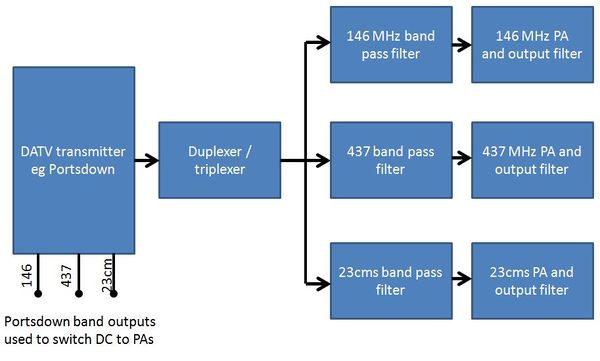Difference between revisions of "Filters"
| Line 9: | Line 9: | ||
*[[23cms filters]] | *[[23cms filters]] | ||
*[[13cms filters]] | *[[13cms filters]] | ||
| + | |||
| + | Rather than use a lossy expensive RF relay on the output of the DATV transmitter we can use a duplexer (for just 146 and 437 MHz operation) or a triplexer filter - as well as providing automatic band switching the duplexer (or triplexer) provides some bandpass filtering on the transmitter output! | ||
| + | |||
| + | [[File:tx filter 1.JPG|600px]] | ||
| + | |||
| + | Note - the band switching pins on the Rpi GPIO can then be used to switch DC volts to the right PA in use. | ||
Revision as of 10:11, 16 January 2017
It is absolutely essential that filters are used on the output of the Portsdown and any other wide band DATV transmitter such as DTX1 and DATVexpress to remove harmonics of the wanted signal. Just try tuning your receiver to 439.5 when transmitting on 146.5 MHz!
The same also applies to the input of any ATV or DATV receiver which uses a wide band satellite tuner in the front end (all of them) - this is because these tuners were designed to be used in a "closed system" and connected directly to an LNB on a dish pointing at the clear sky. This is very different to being connected to a "wide band" yagi antennae which will also pick up PMR and paging systems, short range devices and broadcast transmitters many of which are digital and just produce white noise so you cannot tell you are being overloaded by them!
Luckily there's a lot of filter designs available for both transmit and receive:
Rather than use a lossy expensive RF relay on the output of the DATV transmitter we can use a duplexer (for just 146 and 437 MHz operation) or a triplexer filter - as well as providing automatic band switching the duplexer (or triplexer) provides some bandpass filtering on the transmitter output!
Note - the band switching pins on the Rpi GPIO can then be used to switch DC volts to the right PA in use.
